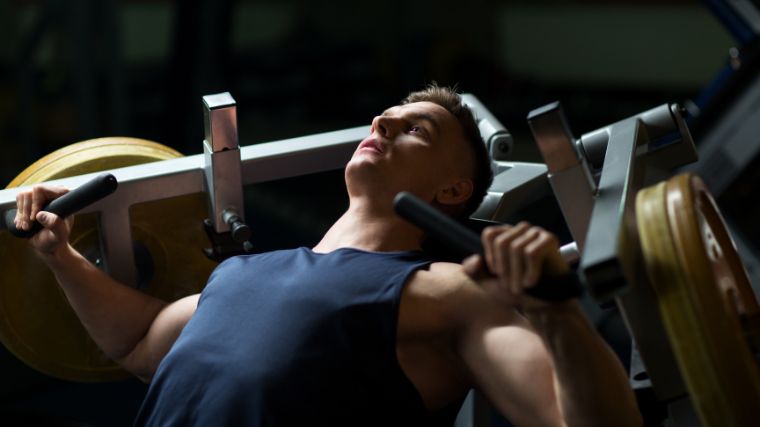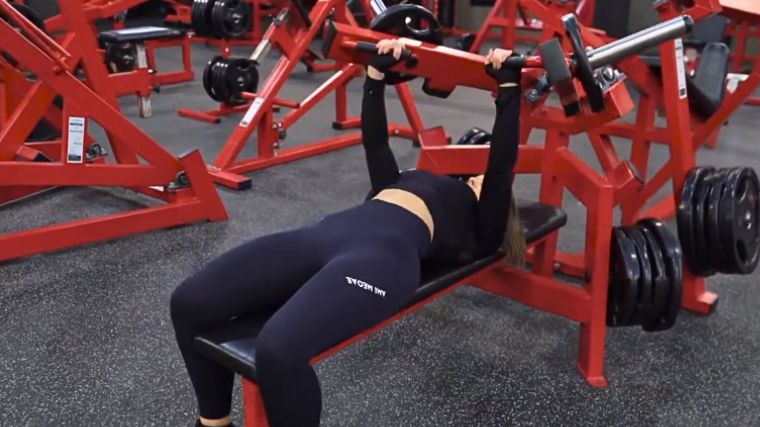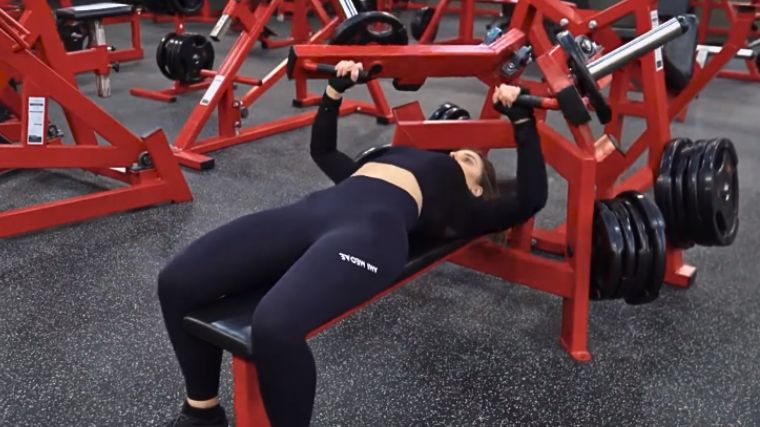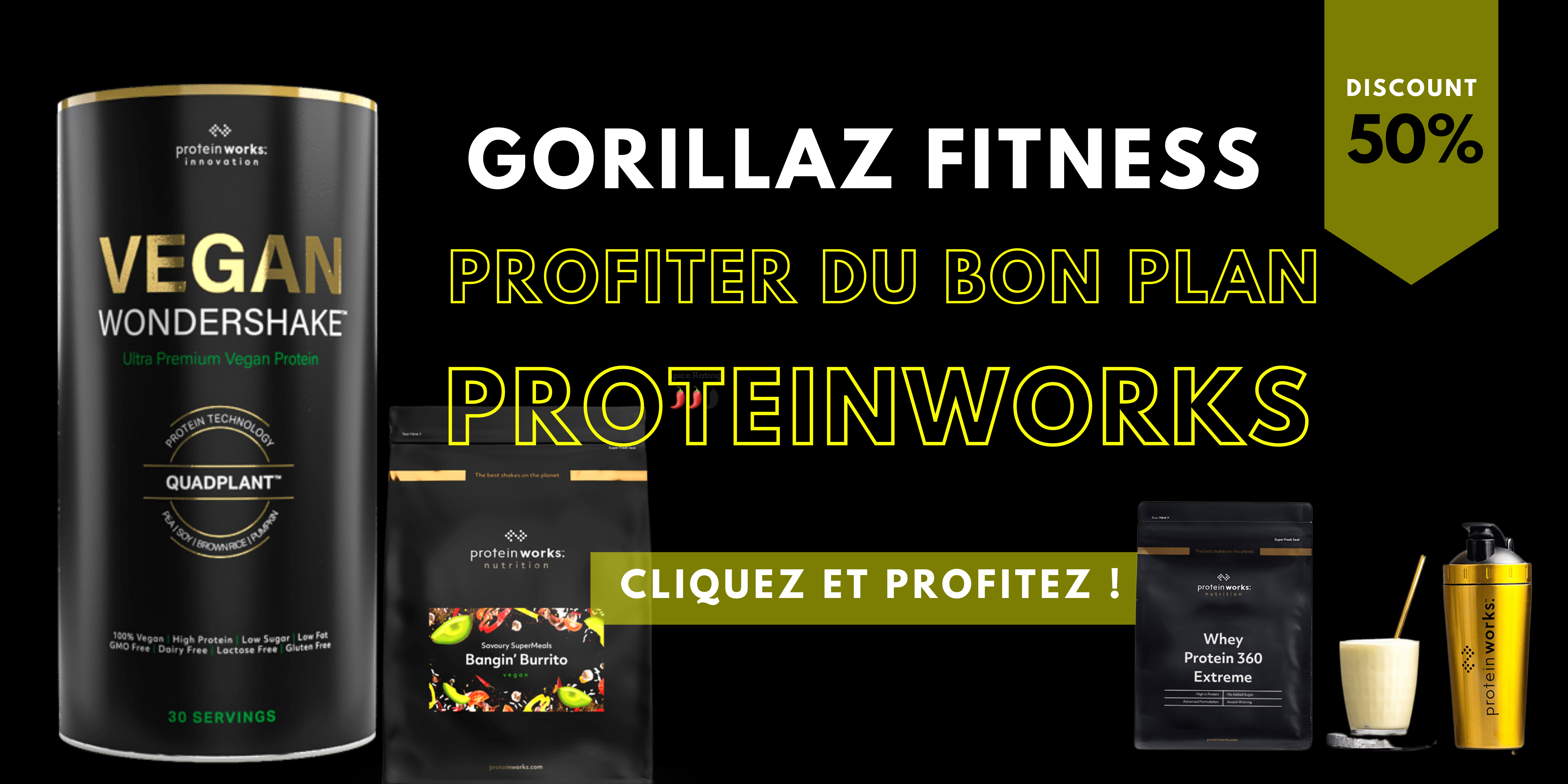The chest press machine is a frequent object of weight room snobbery. Weightlifting purists who eschew the use of machines under all circumstances have been known to dismiss the chest press machine as a poor substitute for a traditional barbell bench press. While it’s true that the barbell bench press is considered the chest-building standard in the weight training world, and for good reason, that doesn’t mean a good chest press machine shouldn’t occupy a cherished place in your training routine.
If you’re a beginner, the chest press machine can help you acclimate yourself to the bench pressing motion in a low-risk fashion, and the same holds true if you’re recovering from an injury. Beyond that, if you’re a weight room veteran, the chest press machine might be the tool that finally helps you blast through some of your pressing plateaus.

In fact, no matter what your upper-body fitness goals are, there’s an outsized chance that a chest press machine can assist you with reaching them.
Editor’s Note: The content on BarBend is meant to be informative in nature, but it should not be taken as medical advice. When starting a new training regimen and/or diet, it is always a good idea to consult with a trusted medical professional. We are not a medical resource. The opinions and articles on this site are not intended for use as diagnosis, prevention, and/or treatment of health problems. They are not substitutes for consulting a qualified medical professional.
How to Do the Chest Press Machine
The chest press machine may appear to be a straightforward muscle-building mechanism, and that’s because it is. Still, you’ll want to make sure you’re completing your reps with textbook precision to maximize the use of your time.
Step 1 — Position Yourself Properly

Lie on your back with one hand on each of the machine’s handles. Position your hands so that they’re wider than shoulder-width apart, and in the middle of your chest.
Coach’s Tip: If you’re using a seated chest press machine, remember that there is a reduced need to brace your feet in this exercise than in a typical bench press. However, you must prioritize the height of your body in the seat so that the handles are set at an optimal level.
Step 2 — Push the Weight Up

Engage the muscles in your chest, arms, and shoulders to press the handles upward until your arms are straightened.
Coach’s Tip: Many chest press machines enable you to preemptively prop the weight into a comfortable starting position that doesn’t compromise the comfort of your shoulders. You can then lower the weight to achieve an ideal range of motion.
Step 3 — Pause For A Second

Pause at the peak of the chest-pressing motion and manually squeeze your chest muscles to ensure that your pecs are at max contraction.
Coach’s Tip: While you’re focused on your upper chest, don’t exaggerate the lock-out process with your arms, as this can result in your elbows becoming unnecessarily strained.
Step 4 — Slowly Bring the Weight Back

Maintain control over the weight as you slowly lower the handles back to their starting position.
Coach’s Tip: If the handles of your chest press machine have levers to lock it in place, engage the lever to avoid placing your shoulders in a dangerous position at the bottom of the range of motion.
Chest Press Machine Variations
Although the chest press machine takes the core elements of the bench press and simplifies them somewhat, there are still several alternative variations of the chest press machine itself. In all actuality, the majority of those machines are intended to make the chest pressing exercise even easier.
From varying the orientation of your body to altering the direction of the resistance, all of these modifications will provide you with a serviceable replication of the basic function of a chest press machine.
Seated Chest Press
(Read More: The Best Foods for Energy Before, During, and After Your Workouts)
- Place yourself in the seat with your back against the pad and your hands at chest level.
- Press the handles outward and away from your body.
- Return the weight to its starting position.
Cable Chest Press
(Read More: The Complete Guide to Pre-Workout Supplements)
- Stand between two cable pulleys, holding one handle in each hand at chest level, and position your body forward enough to create tension in the cables.
- Press the handles outward and away from your body.
- Return the weight to its starting position.
Hammer Strength Chest Press
(Read More: Nutrition for Athletes — How to Eat for Muscle and Performance)
- Seat yourself with your back against the pad and your hands at chest level.
- Press the handles outward and away from your body.
- Return the weight to its starting position.
Chest Press Machine Alternatives
If you’re looking for a similar chest-building method that is only superficially different from the chest press machine, but which still accomplishes the same core goals, we’ve got several options for you to select from.
Barbell Bench Press
(Read More: The Definitive Guide to Bodybuilding Meal Prep)
- Lie on your back with a barbell suspended over your head on a rack.
- With two hands, lift the barbell from its position on the rack and lower the bar to your chest.
- Press the bar back to its starting position.
Dumbbell Bench Press
(Read More: The Gymgoer’s Guide to Whey Protein)
- Lie on your back with one dumbbell in each hand, and with the weights fully extended over your body.
- Bend at your elbows to lower the dumbbells to your chest.
- Press the dumbbells back to their starting position.
Machine Chest Fly
(Read More: The 12 Best Supplements for Muscle Growth (Spring 2023 Update))
- Place yourself in the seat of the machine with your back against the pad and your hands on the handles, or your forearms on the pads.
- Squeeze from your chest to move the handles or pad toward one another at the center of your chest.
- Relax your chest to return the weight to its starting position.
Chest Press Machine Tips
The chest press machine’s apparent simplicity conceals features that may prove to be problematic with respect to the execution of reps on the machine, or in terms of navigating your way toward your goals by way of the chest press machine’s functionality.
None of these issues are overwhelming, but neglecting to account for them may leave you wondering why your chest isn’t responding to resistance the way you would like it to. Put simply, employ these tips to get the most value out of your workouts.
Check the Trajectory
If you have zero familiarity with the chest press machine you’re actually going to be using, press your way through the full range of motion of the machine and identify what the path of the bar looks like. The bar might move straight up, but depending on the machine, the bar might also move in an arc pattern, or trail up from your chest and towards your natural line of sight.
In addition, the handles may shift from out to in as they ascend, at least attempting to mimic the natural, untethered movement pattern of your hands as if you were bench pressing with a pair of dumbbells. This may be a desired feature in theory, but the fixed pattern may also be uncomfortable for you. Either way, it’s best to test out the machine beforehand so that its idiosyncrasies don’t catch you off guard.
Check the Depth
Many chest press machines arrive permanently attached to a bench with a fixed height, so what you see is what you get. Other chest press machines permit you to swap out whatever weight bench you desire. In this instance, one of your prerequisite steps should be to gauge the starting point of the machine’s handles.
If the starting position of the handles is too high, your pecs won’t reap the benefits of being worked through their full range of motion. If the handles are too low, you won’t suffer from any range-of-motion issues, but initially elevating the handles into a starting position might be a grueling task for your shoulders. Either way, you’ll want to take preemptive steps to ensure that the handles begin at an appropriate depth.
Chest Press Machine Sets and Reps
The safety and dependability of a chest press machine makes it a reliable contraption for achieving all of your goals, whether you prioritize size, strength, or endurance training. No matter what your goal is, this machine will help you achieve your goal safely.
- For Muscle Mass: Perform three sets of eight to 12 reps, taking special care to pause at the peak of each rep.
- For Strength: Complete five sets of five reps, being careful not to propel the weight out of the grasp of your hands.
- For Endurance: Execute two sets of 20 reps, paying very close attention to your form early in the sets when the weight seems lighter.
Benefits of the Chest Press Machine
Despite what some misguided soul might have led you to believe, the chest press machine can benefit your upper body in many desirable ways. All of these physical acquisitions will stem directly from the chest press machine’s ability to force you to recruit a vast chunk of your muscle fibers to help you hoist a hefty amount of weight.
A Meatier Chest
The chest press is going to break down copious amounts of all of the muscle fibers running throughout your chest, and especially within the large sternocostal head running through the center of your chest. If you train for muscle hypertrophy, this is going to result in visible growth of your chest’s most prominent muscles.
(Read More: 5 Bench Press Programs to Build a Bigger, Stronger Chest)
A Powerful Push
For the development of raw pushing power, it’s very difficult to top the chest press. When using the machine, you aren’t required to balance a barbell and have zero fear of the potential catastrophe, so you can focus all your efforts on propelling the weight upward. This also means that you can confidently stretch the limits of your power potential and rapidly boost your overall shoving strength.
Fearless Training Style
One of the limitations to the barbell bench press is the tendency to carry out your lifts in an enduring state of dread. You might be wondering if you’ll fail to the point where you can no longer press the weight back to the rack or become distracted by the thought that you are going to fail. By eliminating all of those risks — at the cost of some stabilization activity — the chest press allows you to fail fearlessly, knowing that you won’t get crushed for attempting heavier weights.
Muscles Worked by the Chest Press Machine
The chest press machine requires all the muscles your body enlists for pushing. This includes many upper-body muscles that might seem obvious, along with other muscles that assist you in less evident ways.
Chest
The large, standout muscles at the front of your upper torso contribute the bulk of the force you’ll need to thrust the handlebars skyward.
Triceps
The powerful muscles along the back of your upper arms chip in to assist your chest as your arms straighten to drive the handles upward.
Shoulders
As the handlebars move from their low position to an upward position, your shoulders (both lats and delts) move from down and back to up and in, contributing to the inward squeeze of your chest muscles.
Serratus
Extending from your chest down into your rib cage, your serratus muscles contract when a weight achieves its point of peak extension by being pressed away from your body.
Who Should Use the Chest Press Machine
Plenty of people can benefit from a bigger, stronger, more capable chest. Nevertheless, there are a few key subsets of lifters who might take a particularly keen interest in the most prominent characteristics of the chest press machine, especially those that differentiate it from some of its chest-training counterparts.
Beginners
The chest press machine is a perennial favorite of rookie lifters for three key reasons:
- The lack of a solid bar eliminates the lingering threat of decapitation that hovers over all barbell bench pressing.
- The guided nature of the exercise enables trainees to put all of their effort into lifting and lowering the weight without struggling to balance it.
- The capability to start and end the exercise with the weight resting in a downward position means that you sidestep the requirement to lift the bar from a rack, balance it during a lift, and re-rack it after a set’s conclusion.
(Read More: Get Freakishly Strong With the 5×5 Workout Program)
Bodybuilders
As awesome as barbell bench pressing and dumbbell bench pressing are for chest development, the chest press machine is uniquely exceptional for maximizing hypertrophy. The reason for this stems from your opportunity to fearlessly press heavier quantities of weight than you might otherwise be able to lift if you were training with a barbell that you were required to balance. Not only is failure less physically damaging on a chest press machine, but there is also far less need for a spotter to bail you out during heavy lifts.
Powerlifters
Training for the strongest imaginable bench press is one of the three foremost goals of many powerlifters, right along with maximizing weight quantities on the squat and deadlift. While the chest press machine might seem like the antithesis of the classic free-weight-lifting method that the barbell bench press embodies, it does have one supremely helpful power-building function.
(Read More: How Much Protein Do You Actually Need Per Day?)
If you have the correct type of chest press machine at your disposal, you can preset the range of motion right at your sticking point, and load up the machine with hundreds of pounds. In so doing, you have crafted the means to prepare yourself to unleash a burst of power at that precise point, thereby helping your body to blast through its lifting plateaus.
Common Chest Press Machine Mistakes
Just because the chest press machine has eliminated several of the hazards that are present during free-weight pressing movements, that doesn’t mean it’s impossible to bungle the execution of the exercise. In fact, it’s the very advantages that the chest press machine provides you with that might coax you into making some of these rather seductive missteps.
Limiting the Range of Motion
There might be an objectively wise reason to intentionally limit your range of motion on the chest press machine if you’re tackling your niggling sticking points. However, the appeal of lifting an unprecedented amount of weight over your body while starting from a bottom position can be offset by the temptation to shorten your range of motion to give yourself an advantage. If you do that, you’ll be cheating yourself out of the benefits you would receive by forcing your muscles through the breadth of their functionality.
(Read more: Build a Titanic Torso with These Bodybuilding Chest & Back Workouts)
Deviating from Proper Form
Being relieved of the burden of needing to balance the weight only works to your advantage if you keep your lifting form as strict as possible. With that being said, the fact that the weight can only move in one direction has led many lifters to wriggle around and contort their bodies into all sorts of figurative knots just to elevate the handles to the topmost position. If you lift in this manner, you’ll be defeating the purpose of the exercise, which is to capitalize on the freedom offered by the chest press machine to get the most out of a well-executed lift.
Lifting Too Heavy
While taking risks with the weight is one of the alluring opportunities that the chest press machine presents you with, there’s a chance you might take things a little too far.
(Read More: The Best Protein Intake Calculator for Muscle Gain and Fat Loss)
How far is too far? Well, if your goal is to train for chest hypertrophy, then boosting the amount of weight you’re pressing to such an extent that your rep count dips from nine to four might be doing your ego a world of good, but it probably isn’t getting you any closer to achieving your most lofty aspirations.
Final Thoughts
Whether you make the chest press machine the bedrock of your chest workout routine or you simply wander over to it as a strategic step when you’re looking to surge past a plateau, the chest press machine can fill a valuable role in your workout routine. Seriously, don’t let the gym snobs steer you away from this machine. As long as you can showcase the hard-won benefits of training on a chest press machine, your peers will be too busy marveling at your might or praising your pecs to care about which tools you used to mold them.
FAQs
You’re bound to have a few questions about where the chest press machine might be featured in your workout. Here are some answers for you.
If I use a chest press machine, do I still need to bench press?
Not necessarily. If your only goal is to adequately train the muscles of the chest to induce hypertrophy, the chest press machine can accomplish this. Some lifters wishing to be thorough have used the chest press machine to finish off their chests after initially bench pressing with free weights to preemptively fatigue their stabilizer muscles.
Does the chest press machine train any other muscles besides my chest?
It does. The chest press involves all of your muscles involved with pushing, including your chest, shoulders, triceps, and serratus muscles.
How often should I do the chest press machine?
It varies. Many lifters who use the chest press machine make use of it amidst an assortment of other exercises during either a dedicated chest day, a chest-and-tricep day, or a push day. In all three of these instances, there would be little reason to do the chest press more than two times per week.
Featured Image: Ground Picture / Shutterstock
Comment utiliser la machine de presse thoracique pour des performances pectorales
Introduction
La machine de presse thoracique est un équipement de musculation communément utilisé pour renforcer et développer les muscles pectoraux. Elle est particulièrement efficace pour briser les plateaux et stimuler la croissance musculaire des pectoraux. Dans cet article, nous vous guiderons sur la meilleure façon d’utiliser la machine de presse thoracique pour obtenir des gains significatifs.
Technique de base de la machine de presse thoracique
Voici les étapes pour utiliser correctement la machine de presse thoracique :
1. Ajustez le siège et les bras
Commencez par ajuster le siège afin que les poignées de la machine soient à la hauteur de votre poitrine lorsque vos bras sont tendus devant vous. Assurez-vous que le dossier est bien calé contre votre dos.
2. Positionnez-vous correctement
Asseyez-vous sur le siège et placez vos pieds à plat sur le sol, écartés à la largeur des épaules. Gardez une posture droite avec vos épaules en arrière et votre poitrine relevée.
3. Saisissez les poignées
Saisissez les poignées de la machine avec une prise ferme et équilibrée. Vos mains doivent être alignées avec vos épaules et vos coudes légèrement fléchis.
4. Exécutez le mouvement
Poussez les poignées devant vous en utilisant principalement votre force pectorale. Assurez-vous de garder vos coudes à la hauteur de vos épaules ou légèrement plus bas. Lorsque vous atteignez la position maximale, contractez vos muscles pectoraux pendant quelques secondes avant de relâcher lentement et de revenir à la position de départ.
5. Contrôlez votre respiration
Pour de meilleurs résultats, inspirez profondément avant de commencer le mouvement et expirez en poussant les poignées vers l’avant. Maintenez une respiration régulière et contrôlée tout au long de l’exercice.
Conseils supplémentaires pour des gains pectoraux optimaux
Voici quelques conseils supplémentaires pour maximiser vos gains pectoraux lorsque vous utilisez la machine de presse thoracique :
1. Variez les angles
Utilisez la machine de presse thoracique sous différents angles pour cibler différents muscles pectoraux. Effectuez des séries d’exercices inclinées, déclinées et à plat pour stimuler l’ensemble de votre poitrine.
2. Augmentez progressivement la charge
Pour prévenir les plateaux et continuer à progresser, augmentez progressivement la charge de poids que vous utilisez sur la machine de presse thoracique. Cependant, assurez-vous de maintenir une bonne forme pour éviter les blessures.
3. Maintenez une bonne technique
La technique est primordiale pour obtenir des gains optimaux. Veillez à maintenir une bonne posture, à garder vos coudes dans un alignement approprié et à contrôler le mouvement en utilisant principalement vos muscles pectoraux.
FAQ
Q : Combien de séries et de répétitions dois-je effectuer ?
R : Il est recommandé de faire entre 3 et 5 séries de 8 à 12 répétitions pour stimuler la croissance musculaire. Cependant, le nombre de séries et de répétitions peut varier en fonction de votre niveau de condition physique et de vos objectifs personnels.
Q : Comment puis-je éviter les blessures lors de l’utilisation de la machine de presse thoracique ?
R : Assurez-vous de maintenir une bonne forme et de ne pas utiliser une charge de poids excessive. N’hésitez pas à demander l’aide d’un instructeur de fitness pour vous guider sur la bonne technique.
Q : Est-il préférable d’utiliser la machine de presse thoracique avant ou après d’autres exercices pectoraux ?
R : Cela dépend de vos préférences personnelles. Certains préfèrent commencer leur entraînement pectoral avec la machine de presse thoracique pour pré-fatiguer les muscles, tandis que d’autres choisissent de l’utiliser à la fin pour un effort final.
Q : Puis-je utiliser la machine de presse thoracique tous les jours ?
R : Il est généralement recommandé de laisser un jour de repos entre les séances d’entraînement des pectoraux pour permettre aux muscles de récupérer et de se développer. L’utilisation quotidienne de la machine de presse thoracique peut entraîner une surutilisation et des blessures.
Conclusion
Utiliser la machine de presse thoracique de manière correcte et efficace peut vous aider à briser les plateaux et à obtenir des gains pectoraux significatifs. Assurez-vous de suivre la technique de base, de maintenir une bonne posture et de progresser progressivement. N’oubliez pas de consulter un professionnel de la remise en forme si vous avez besoin d’aide supplémentaire ou de conseils personnalisés.
.

